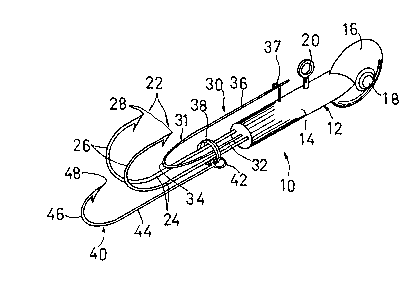Some of the information on this Web page has been provided by external sources. The Government of Canada is not responsible for the accuracy, reliability or currency of the information supplied by external sources. Users wishing to rely upon this information should consult directly with the source of the information. Content provided by external sources is not subject to official languages, privacy and accessibility requirements.
Any discrepancies in the text and image of the Claims and Abstract are due to differing posting times. Text of the Claims and Abstract are posted:
| (12) Patent Application: | (11) CA 2053486 |
|---|---|
| (54) English Title: | FISHING LURE |
| (54) French Title: | APPAT DE PECHE |
| Status: | Deemed Abandoned and Beyond the Period of Reinstatement - Pending Response to Notice of Disregarded Communication |
| (51) International Patent Classification (IPC): |
|
|---|---|
| (72) Inventors : |
|
| (73) Owners : |
|
| (71) Applicants : | |
| (74) Agent: | ADE & COMPANY |
| (74) Associate agent: | |
| (45) Issued: | |
| (22) Filed Date: | 1991-10-15 |
| (41) Open to Public Inspection: | 1993-04-16 |
| Availability of licence: | N/A |
| Dedicated to the Public: | N/A |
| (25) Language of filing: | English |
| Patent Cooperation Treaty (PCT): | No |
|---|
| (30) Application Priority Data: | None |
|---|
- 8 -
FISHING LURE
ABSTRACT OF THE DISCLOSURE
A fishing lure has a lure body carrying two
fixed hooks and a safety pin at the trailing end, with
all three components projecting to the top of the lure
body. The safety pin is located between the two upwardly
divergent hooks and serves to engage a minnow with the
lure. A ring is fitted on the hook shanks and on the
safety pin for free movement and carries a moveable
trailing hook that is, in use, engaged with the tail of a
minnow carried by the lure. The moveable hook does not
restrict movements of the minnow but acts to hook any
nibbling fish. The safety pin acts as a retainer
retaining the moveable hook carrying ring on the lure.
Note: Claims are shown in the official language in which they were submitted.
Note: Descriptions are shown in the official language in which they were submitted.

2024-08-01:As part of the Next Generation Patents (NGP) transition, the Canadian Patents Database (CPD) now contains a more detailed Event History, which replicates the Event Log of our new back-office solution.
Please note that "Inactive:" events refers to events no longer in use in our new back-office solution.
For a clearer understanding of the status of the application/patent presented on this page, the site Disclaimer , as well as the definitions for Patent , Event History , Maintenance Fee and Payment History should be consulted.
| Description | Date |
|---|---|
| Time Limit for Reversal Expired | 1999-10-15 |
| Application Not Reinstated by Deadline | 1999-10-15 |
| Deemed Abandoned - Failure to Respond to Maintenance Fee Notice | 1998-10-15 |
| Inactive: Abandon-RFE+Late fee unpaid-Correspondence sent | 1998-10-15 |
| Application Published (Open to Public Inspection) | 1993-04-16 |
| Abandonment Date | Reason | Reinstatement Date |
|---|---|---|
| 1998-10-15 |
The last payment was received on 1997-09-25
Note : If the full payment has not been received on or before the date indicated, a further fee may be required which may be one of the following
Patent fees are adjusted on the 1st of January every year. The amounts above are the current amounts if received by December 31 of the current year.
Please refer to the CIPO
Patent Fees
web page to see all current fee amounts.
| Fee Type | Anniversary Year | Due Date | Paid Date |
|---|---|---|---|
| MF (application, 6th anniv.) - small | 06 | 1997-10-15 | 1997-09-25 |
Note: Records showing the ownership history in alphabetical order.
| Current Owners on Record |
|---|
| W. EDWARD ISAAC |
| Past Owners on Record |
|---|
| None |